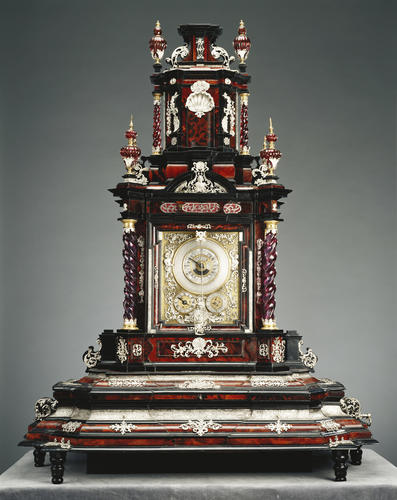Jacob Mayr (c. 1648-1714)
Table clock c.1710
Turtle shell, silver, glass, ebony, ormolu | 100.0 x 76.0 x 52.0 cm (whole object) | RCIN 90415
Queen's Drawing Room, Windsor Castle
-
An extract from E.J. Wood's 'Curiosities of Clocks and Watches from the Earliest Times' published in 1866:
'... large astronomical clock of the seventeenth century, the framework covered with turtleshell and silver appliqué scrolls and silver bands. The pedestal is quadrangular with shaped sides. This square clock has four twisted columns of Venetian glass in imitation of amythyst, and on each side is a silver oblisk of repoussé masks and scrolls, with an eagle at the top. There are dials on all the four sides, that on the front has a deep silver revolving-plate, with a calendar for every day of the year and two smaller dials denoted the hour and the signs of the zoliac. The pendulum has a figure of time. On the back are astrological dials. On the pediment are two seated figures. Above is a sort of temple with two twisted ruby glass columns, two silver figures in niches, and ruby glass at the corner, surmounted by a gilt figure of Atlas supporting a globe.'
The 30 hour movement strikes the hours and quarters and includes an alarm. The hours can be sounded on either the 12 or 24 hour system. The various dials, besides showing the time, provide an annual calendar with the saints’ Days, and indicate the hours of daylight and darkness throughout the year. The lower dials are for setting the alarm (left) and for showing the position of the sun in the zodiac (right). Dials on each side of the movement show which hours and quarters last struck. The other main dials provide astronomical and lunar information. Four subsidiary dials provide the selection for 12 or 24 hour striking, a strike silent device, indications of the Golden Number with the Epact and Dominical letter, and the fourth dial shows the days of the week with their planetary signs.
Below the clock in the elaborate case is the music box that plays seven tunes played on metal blocks. Made by Jacob Mayr Augsburg circa 1710. -
Creator(s)
(clockmaker) -
Medium and techniques
Turtle shell, silver, glass, ebony, ormolu
Measurements
100.0 x 76.0 x 52.0 cm (whole object)
Alternative title(s)
Augsburg Clock








